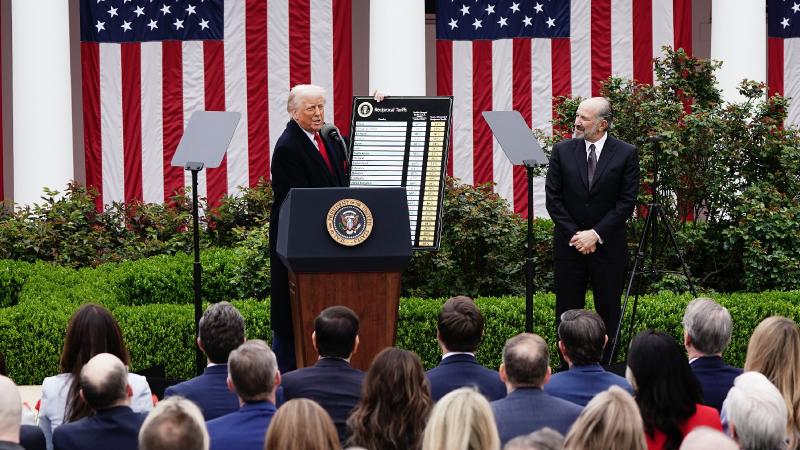Trump Announces Sweeping Tariffs on All Imports - The New York Times



A 10 percent tariff will apply to all countries, but key trading partners like China, Japan and Europe will face rates two and three times as high.
Updated April 2, 2025, 5:17 p.m. ET
Ana Swanson, Alan Rappeport and Tony Romm
Here's the latest.
President Trump unveiled his most expansive tariffs to date in a ceremony at the White House on Wednesday afternoon, saying he would impose a 10 percent tariff on all trading partners as well as double-digit "reciprocal" tariffs on dozens of other countries that administration officials said had treated the United States unfairly.
The tariffs will apply to more than 100 trading partners, including the European Union, China, Britain and India.
Under Mr. Trump's plan, the United States will impose a staggering new 34 percent tariff on Chinese goods, on top of the 20 percent levy he already imposed on Beijing.
Some of Mr. Trump's steepest rates apply to U.S. allies, including a 20 percent tariff on imports from the European Union and a 24 percent tariff on goods from Japan. India will face a 26 percent tariff on its exports to the United States. These figures include the 10 percent baseline tariff.
White House officials said that pernicious trading practices by other countries had led to large and persistent trade deficits for the United States, and that other products, like lumber, copper, semiconductors, pharmaceuticals and critical minerals could face additional tariffs.
In a briefing with reporters, senior administration officials added they had little appetite for haggling over lower tariff rates, even with U.S. allies that have offered to reduce their own levies on American exports in recent days. They also issued an early warning to countries that have threatened to impose retaliatory tariffs against the United States.
Mr. Trump at one point described his approach as "kind," explaining that the government would only be charging other countries half of the rate that they had calculated should be applied based on those countries' trade practices. He framed his policies as a response to a national emergency, saying that tariffs were needed to boost domestic production.
"We're going to start being smart, and we're going to start being very wealthy again," Mr. Trump said.
Mr. Trump had promised for months to imposethe tariffs, which the president says will correct years of "unfair" trade in which other countries have been "ripping off" America.
Here's what else to know:
-
Markets react: Wall Street shuddered as Mr. Trump announced the tariffs, with early market reaction pointing to a further slide in the stock market and a weakening dollar. Futures on the S&P 500, which allow investors to trade outside normal trading hours, slumped nearly 2 percent, erasing the day's gain of 0.7 percent.
-
European response: European officials are poised to respond to Mr. Trump's steel and aluminum tariffs with countermeasures. Although the bloc so far has concentrated on imposing higher tariffs on a wide variety of goods — whiskey, motorcycles and women's clothing are among the products that could be affected — officials are also open to placing trade barriers on services, using a new trade weapon that was developed only in 2021 to target Big Tech and Wall Street.
-
Tariff options: The administration has been weighing several different tariff strategies in recent weeks, including a 20 percent flat tariff on all imports, which Trump advisers have said could help raise more than $6 trillion in revenue for the U.S. government. Advisers have also discussed the idea of assigning different tariff levels to countries depending on the trade barriers those countries impose against American products, or exempting them from tariffs entirely through trade deals.
-
Imported automobiles hit: New tariffs on automobiles made outside the United States go into effect on Thursday, adding to previous tariffs on steel, aluminum and other imports worth billions of dollars that Mr. Trump has imposed since returning to office in January.
Ana Swanson
International trade reporter
The National Retail Federation said in a statement that the tariffs would cause more anxiety and uncertainty for American businesses and consumers. Tariffs are not paid for by foreign countries or suppliers, but by U.S. importers, the group said, adding that "the immediate implementation of these tariffs is a massive undertaking." Typically governments give a lot more notice for changes to tariffs to give business time to prepare.
April 2, 2025, 5:17 p.m. ET
Tony Romm
Economic policy reporter
The National Association of Manufacturers said it is still parsing the details and implications of the president's tariffs. But the group's president, Jay Timmons, said in a statement: "The high costs of new tariffs threaten investment, jobs, supply chains and, in turn, America's ability to outcompete other nations and lead as the preeminent manufacturing superpower."
April 2, 2025, 5:15 p.m. ET
Joe Rennison
Financial markets reporter
Wall Street shuddered as President Trump announced sweeping tariffs on countries across the globe on Wednesday, with the early market reaction pointing to a further slide in the stock market and a weakening dollar. Futures on the S&P 500, which allow investors to trade the index outside normal trading hours, slumped nearly 2 percent, erasing an earlier gain of 0.7 percent while exchanges were open.
April 2, 2025, 5:12 p.m. ET
Rich Barbieri
Several hours before the stock market will open in Tokyo, futures on Japan's Nikkei 225 index tumbled more than 2 percent, signaling what could be a rough Thursday for investors. The 25 percent tariffs on cars that Trump announced last week, and which are about to take effect, could be a devastating blow to the export-intensive Japanese economy.
April 2, 2025, 5:10 p.m. ET
Rebecca F. Elliott
The U.S. energy industry could suffer if countries retaliate against the tariffs President Trump announced today. The United States produces more petroleum and natural gas than any country in the world, and it exports much of that fuel in the form of oil, gasoline, diesel and liquefied natural gas. China, Japan and members of the European Union are among the top buyers of U.S. natural gas and petroleum products, according to the Energy Information Administration.
April 2, 2025, 5:08 p.m. ET
Ben Casselman
Economics reporter
It's worth noting that the figures on Trump's chart for the tariffs imposed on the United States by other countries include "currency manipulation and trade barriers." It isn't clear exactly how the administration is coming up with those figures, but it's possible they include things like the value-added taxes that are common in many European countries. Economists argue those taxes should not be considered trade barriers.
April 2, 2025, 5:06 p.m. ET
Alan Rappeport
Economic policy reporter
Top Democrats continued to pan Trump's tariffs. Senator Ron Wyden of Oregon said that they would raise prices and fuel uncertainty: "Trump's short-sighted tariff plan won't rebuild American manufacturing or help working families get ahead. It's a tax on almost everything families buy, so Trump can give his billionaire friends a tax cut."
April 2, 2025, 5:05 p.m. ET
Matina Stevis-Gridneff
Canada bureau chief
The majority of the nations listed for "reciprocal" tariffs on the eight-page document distributed to reporters by the administration are poor, developing economies. They include some of the world's poorest nations -- South Sudan, Burundi and the Central African Republic -- as well as countries in the throes of war, notably Sudan.
April 2, 2025, 5:04 p.m. ET
Ana Swanson
International trade reporter
We've just gotten clarification from the White House that the tariff numbers in the charts Trump held up include both reciprocal levies and the 10 percent baseline. So Europe will face a 10 percent reciprocal tariff and a 10 percent baseline. China will face a 24 percent reciprocal tariff, on top of the 10 percent baseline. This is all happening in real time so the numbers were not clear at the outset.
April 2, 2025, 5:02 p.m. ET
Andrew Duehren
Tax policy reporter
Trump once again touted his idea of allowing Americans to deduct interest payments on auto loans from their tax bills, but only if the car was made in America. His administration has presented this plan as a way to make up for the higher automobile prices created by his tariffs, though it is unclear how many Americans will actually be able to take advantage of the tax break. Many low income Americans do not owe much in income taxes to begin with.
Ana Swanson
International trade reporter
Many people had been expecting the president to announce high tariffs today, but the numbers that he just revealed are stunning. In addition to a 10 percent tariff on all countries except Canada and Mexico, dozens of other countries will face extra tariffs. That will likely force some manufacturing back into the United States, but also raise costs for American consumers and manufacturers and incite trade wars on many fronts.
April 2, 2025, 4:58 p.m. ET
Jeanna Smialek
Brussels bureau chief
"There's a reason this came at 4 p.m. Eastern time, with markets closed," said Jorn Fleck, senior director with the Europe Center at the Atlantic Council.
April 2, 2025, 4:58 p.m. ET
Jeanna Smialek
Brussels bureau chief
He said the tariff on the European Union, his area of expertise, is a "very high number" that will be painful for consumers and businesses on both sides of the Atlantic.
April 2, 2025, 4:58 p.m. ET
Alex Travelli
South Asia business and economics reporter
India, like many of America's biggest trading partners, will be shocked by the tariff that Trump has announced. On the calculation that India's average tariff against American goods is 52 percent, he offered a "discounted" reciprocal tariff of 26 percent. But that figure seems to come out of the blue, to trade economists who have been watching.
April 2, 2025, 4:58 p.m. ET
Alex Travelli
South Asia business and economics reporter
India's tariffs vary widely between products, from the 70 percent on motorcycles that Trump mentioned, and even higher for some categories, down to zero on other goods. The World Trade Organization estimates that India's trade-weighted average tariff — taking into account the value of each category traded — was about 12 percent. That's higher than the trade-weighted American average, which was between 2 percent and 3 percent. But those figures suggested that Trump's retaliation might amount to an 8 percent additional levy on Indian goods.
April 2, 2025, 4:53 p.m. ET
Ben Casselman
Economics reporter
Trump said grocery and other prices are starting to come down, and that his policies are bringing down inflation. In fact, inflation has picked up in the first weeks of his term, and economists almost universally expect tariffs to further drive up prices.
Colby Smith
U.S. economy reporter
Trump is emphasizing that manufacturing jobs that have been created since his second term began, as well as that some consumer prices have eased. The issue is that neither of those trends are likely to continue with these tariffs, economists say. A new report released this week showed that manufacturing activity contracted in March and businesses in that sector are now expecting much slower growth and higher prices.
April 2, 2025
Patricia Cohen, Adam Satariano and Eshe Nelson reported from London and Jeanna Smialek from Brussels.
Countries targeted by Trump's tariffs may strike back at U.S. services.
President Trump says he is outraged by the fact that the United States imports more goods than it sends to the rest of the world. What he rarely mentions, though, is that when it comes to services, the tables are turned.
Service sectors — which include the finance, travel, engineering and medical industries and more — make up the bulk of the American economy. Exports of these services brought more than $1 trillion into the United States last year.
But that dominance also gives other countries some clout in negotiations — including the ability to impose some pain on the U.S. economy as they look to retaliate against Mr. Trump's tariffs on goods.
The European Union, for instance, could use tools designed to restrict services coming into the bloc as a cudgel.
"The real leverage that the Europeans have is ultimately on the services side," said Mujtaba Rahman, managing director for Europe at the Eurasia Group, a political research firm. "It will escalate before it de-escalates."
The United States is the largest exporter of services in the world, and a large share of those services, from financial services to cloud computing, are delivered digitally. The country ran a trade surplus in services of nearly $300 billion last year.
Every time a European tourist stays at a U.S. hotel, for example, the money spent is counted in the services export basket. And every time someone in Canada or Japan or Mexico pays to listen to music or watch movies and television shows made in the United States, they are adding to America's surplus in the services trade.
Many of the countries that the United States is targeting for tariffs run a services deficit with the United States, including Canada, China, Japan, Mexico and much of Europe, according to the U.S. Census Bureau.
"The E.U. is now equipped with policy tools to extend the range of retaliation against U.S. tariffs to target imports of U.S. services," Filippo Taddei, a managing director of global investment research at Goldman Sachs, wrote in a research note about possible European responses.
Arguably the most extreme option is known as the Anti-Coercion Instrument. First proposed in 2021, the tool is largely untested, but it allows the European Union to hit a trading partner with a "wide range of possible countermeasures."
Such measures could include tariffs, restrictions on trade in services and limits on trade-related aspects of intellectual property rights. That could affect American tech giants like Google. Several European diplomats said that use of the tool is a distinct possibility, should the trade war escalate.
While possible restrictions aimed at services would be a new trade war response, Brussels has a history of penalizing the U.S. tech industry for other reasons. For more than a decade, the European Union has gone after Silicon Valley's biggest companies for anticompetitive business practices, weak data privacy protections and lax content moderation policies.
Europe's aggressive oversight has led to notable product changes because the European Union, home to about 450 million people, is a major market. Google has changed the way it displays search results, Apple has tweaked its App Store, and Meta has made adjustments to Instagram and Facebook because of E.U. rules.
Taking aim at the tech industry would intensify a feud with the Trump administration over European tech regulation. Even before the tariff standoff, senior officials including Vice President JD Vance have criticized the European Union for what they view as excessive regulation of American tech companies.
As soon as this week, the European Union was expected to announce new fines against Apple and Meta for violating the Digital Markets Act, a law passed in 2022 intended to make it easier for smaller companies to compete against tech giants. Meta and X are under investigation under another new law, called the Digital Services Act, that requires companies to do more to police their platforms for illicit content.
Britain, on the other hand, may use its rules over service imports as a carrot instead of a stick.
For weeks, British officials have tried to reassure the public that it was in a strong position to negotiate with the Trump administration to avoid tariffs, repeatedly pointing to the relatively balanced goods trade between the two countries. (Britain has a surplus when it comes to services.)
Still, one sore point for Trump administration officials has been Britain's digital services tax, which they say unfairly harms American tech giants. The tax was introduced in 2020 as a 2 percent levy on revenues of search engines, social media services and online marketplaces. It is expected to raise the equivalent of more than $1 billion for the British treasury this fiscal year.
British officials said changes in this are part of negotiations with the Trump administration. Last month, Rachel Reeves, the chancellor of the Exchequer, said, "We've got to get the balance right."
Britain has sought to position itself in a "Goldilocks zone" between the United States and European Union, according to researchers at Chatham House, a research institute, maintaining good relationships with both and keeping some regulation.
If scrapping the digital services tax brings about "a sweetheart deal for the U.K. that avoids the worst of U.S. tariffs, it might prove a masterstroke," wrote the researchers, Alex Krasodomski and Olivia O'Sullivan. "But that is highly uncertain — the president's application of tariffs has been in constant flux."
It was more likely that Britain would eventually have to pick a closer allegiance to either the United States or the European Union, they added.






Yes, that is the most important thing: those charts that show what each country has been charging us.
I'd say Trump has been kind.
... and the real question is...how will these countries react?
I expect that however other countries react, it will - in every instance - be more thoughtful and targeted than what Trump is doing.
The real question is why we tolerated it for so long?
“Liberation Day” is even worse than expected
Paul Krugman
Just a quick update after Trump’s Rose Garden speech.
I guess it’s just possible that when we get details about the Trump tariffs they will be lower than what he just announced, but based on what he said, he’s gone full-on crazy. It’s not just that he appears to be imposing much higher tariffs than almost anyone expected. He’s also making false claims about our trading partners — not sure in this case whether they’re lies, because he may be truly ignorant — that will both enrage them and make it very hard to back down.
Basically, he’s claiming that the rest of the world is placing very high tariffs on U.S. products, and that he’s imposing “reciprocal” tariffs that are only half what they impose on us. Here’s the chart he showed:
The left column show the tariffs others are supposedly charging on US products — and it’s completely crazy. Focus on the European Union. The EU, like the United States, has generally low tariffs; the average tariff it charges on US goods is less than 3 percent.
So where does this 39 percent number come from? I have no idea. Many people speculated that Trump would count value-added taxes as tariffs, even though they aren’t — European producers selling to the EU market pay the same VAT as US producers, so it doesn’t discriminate and therefore isn’t protectionist. But even if you get that wrong, EU VAT rates are in the vicinity of 20 percent, so you still can’t get anywhere close to 39 percent.
You have to wonder whether Elon Musk’s Dunning-Kruger kids are now producing tariff numbers.
But you know that having once claimed that Europe charges tariffs more than 10 times as high as reality, Trump will never drop that claim. I don’t know how many people noticed, but he’s still claiming that we’re subsidizing Canada by $200 billion a year. Aside from the basic mistake of claiming that a Canadian trade surplus means that we’re somehow subsidizing Canada, he’s inflating the actual trade surplus by a factor of three. Many, many people have pointed out the error, but Trump is sticking with it, the same way Musk is sticking with the millions of dead Social Security beneficiaries thing.
If you had any hopes that Trump would step back from the brink, this announcement, between the very high tariff rates and the complete falsehoods about what other countries do, should kill them.
Ummm........... Paul? Donald Trump has been known to lie. Kinda often, in fact...
I know, I know... it's just unthinkable that a President of the United States would ever base important policy on lies... but...
Well it does say “including currency manipulation and trade barriers,” so maybe the math is hiding in there somewhere?
Probably. Most of the economists I read agree that China "cheats" a little. But it's "a little"... and the US can (and does) do the same thing. "Government loans for building private manufacturing plants" is done by both countries. The US is far richer, so it could - if it had a tenth of the political will that China has - put much more into such actions.
But... that would mean taxing some billionaires to subsidize others. China has the will to do that. The US does not. Our billionaires only take government money.
Tell the world's dumbest economist that what we were allowing was unsustainable.
The real world's dumbest economists are any who believe other countries will pay the tariffs Trump imposed on imported goods which will inevitably be paid by American consumers in the USA!
False. There are no tariffs on American goods.
Make it here!
That's nice, how about the materials needed to make those goods?
It appears the deaf, dumb and blind have also lost their sense of smell.
Whereas the Atlanta Fed was expecting a 3.8% economic growth rate this year they now predict a 3.8% economic contraction...
A Recession is what we get with MAGA Flat Earth Economics!
Billionaires.don't give a flying fuck.
I am curious what the conversations were like that developed these numbers and the countries to which they’re being applied. As diverse as it all is, clearly, some thought went into it.
I want to be hopeful about this, but I have to admit I’m not optimistic. Tariffs are such a blunt instrument for a complex issue.
If you’re going to do it, I would guess there is some utility in nailing everyone because otherwise, it’s easy to go around a tariff. For example, if goods from China have a tariff, you can ship it to Bangladesh first, and then to America. And 10% is so nominal, it probably won’t impact prices much, but might make shipping hijinks not worth the trouble? I’m guessing. I don’t actually know much about it.
I would predict, also, that if you raise the price of all foreign cars by 25%, domestic manufacturers will feel empowered to rise their prices by 15%, 20%, or even just match the 25%. So, putting a tariff on foreign cars just makes all cars more expensive. Guess what that’s likely to do to sales? Not to mention maintenance.
The whole thing just feels like Trump has kind of a fetish for tariffs. Like he’s looking for any excuse to impose them, as opposed to settling on them as the best option.
But why? It's not like they will compete with foreign car makers if the price is 25% higher. Is it just greed? They need to think about that. Nobody will be buying cars
American automobile manufacturers are not known for long-term brilliance...
Pricing is market driven. An earlier round of tariffs raised prices on things like washing machines. All washing machine prices rose including those made domestically.
Yep. And they don’t even need to match the tariff-driven price increase. If Toyotas go up in price by 25%, Fords can go up by 15%. They’ll make more profit per car and still cost less than a Toyota. At least some number of people who might have bought a Toyota will buy a Ford instead. It’s win-win, if you’re Ford. They just have to be careful how much they raise the price so as not to hurt sales too much.
Exactly.
The customer is screwed.
But who gives a flying fuck about the customer?
Not to mention maintenance.
And just as importantly, auto insurance. Cars being more expensive to fix means every single insurance customer gets to share the bill, regardless of their decision to not upgrade their vehicle.
Not only will nobody afford to buy a car but those of us that have one won't be able to afford to drive it
Welcome to the Kingdom.
I wouldn’t be surprised if we see lawsuits almost immediately that delay the implementation of some or all of these tariffs.
Republican politicians representing their favored special interests have been begging for exemptions.
Just as they do with regular taxes. Sigh.
Arvo... someone needs to give the Government over there some geography lessons..
They have put a 10% tariff on two Australian territories that are completely uninhabited... McDonald and Heard island are down near Antarctica and are only inhabited by penguins..
I guess they could always get payment in regurgitated fish...🤣
Those penguins have been cheating the US for decades!
I wonder what happened yesterday....
Probably an effect of the pee tapes.
Probably going to wait for the outcome of talks. Right now, Russia has so many sanctions on them that it may not make any difference. Let's wait to see the outcome of all of that